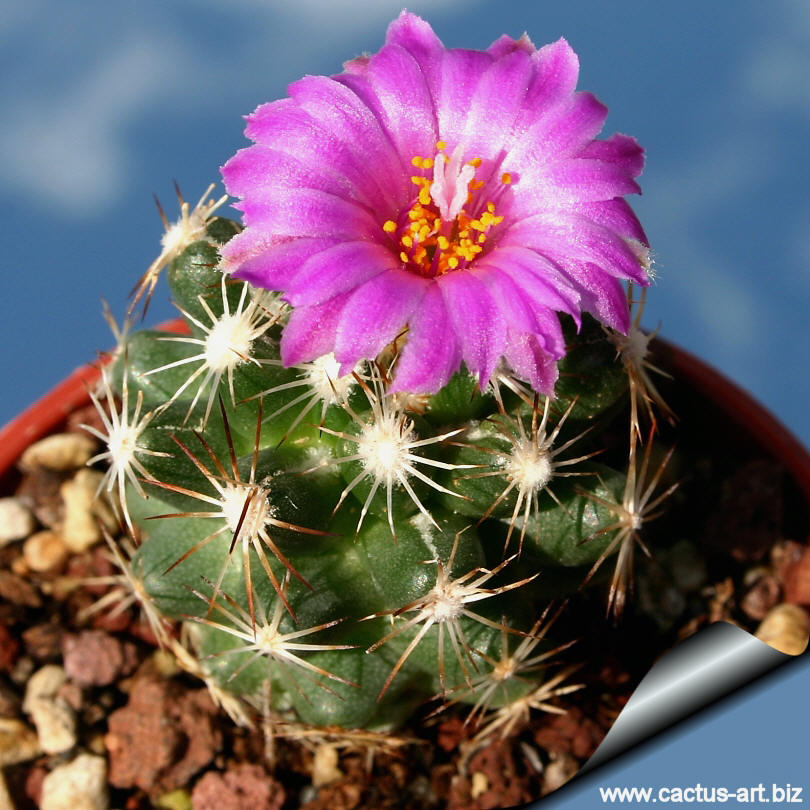|
|
|

Escobaria hesteri
It is an attractive and well worth
cultivating dwarf plant; it starts flowering from an early age and
blooms from spring until late summer, with nice large, deep pink blooms.
In the resting period it will not be damaged by some frost.
|
|
Remarks:
Escobaria hesteri and
E. minima (From an adjacent hill) are
two miniature plant which resemble dwarf races of
E. vivipara, to wich they shares some characteristic, but
much smaller in all parts. They can survive to –25°C in dry-winter
regions. |
|
Taxon
synonyms:
- Coryphantha hesteri
Y. Wright
Cact. Succ. Journ. (US), 4 :
274, fig. (p. 273). 1932
- Mammillaria hesteri
(Y. Wright) D. Weniger, nom. nud.
|
|


Advertising
|
|
|
|
Family:
Cactaceae (Cactus
Family)
|
|
Scientific name: Escobaria
hesteri (Y. Wright) Buxbaum
In: Osterr. Bot. Zeitschr. 98. 78, 1951
(Often misspelled as "hester", "hesterii"
or "esteri")
Origin: Southwestern USA,
Texas: It is endemic to a small area in the maraton basin (Brewster
County) and west of Sanderson (Terrel county)
Habitat: Semidesert grasslands
and oak-juniper-pinyon woodlands on dry, gravely limestone hills,
alluvial fans, rock crevices, and often on outcrops of novaculite (a
hard, fine-grained, silica-rich rock) , sandstone, limestone and several
other types of sedimentary and igneous substrates. Elevational range is
1200-1600 metres. No significant differences have been reported in plant
from the different substrates.
Conservation status: Listed in
CITES appendix 2.
Common Names include: Hester’s pincushion cactus, Hester’s
foxtail cactus.
Etymology: In honour of J.
Pinckney Hester, writer on succulents, who discovered the taxon in 1930
nearby Alpine, Texas.
|
|
|
|
Description: It is a dwarf
cactus unbranched, except in old age, ultimately
offsetting to form clusters & eventually, low many-stemmed mounds
5-20(-30) cm diameter.
Stems: Short stubby egg-shaped up to 4 cm wide, not obscured by
spines when hydrated, obscured when
desiccated. In nature the stem is deep-seated in the soil, the
aerial aerial parts are inconspicuous, flat-topped to hemispheric (to
ovoid or spheric in horticulture), almost completely withdrawing into
substrate when desiccated, 5-9 × 1.5-4.5 cm, above-ground portion 1-6.5;
tubercles 5-9 × 4-6 mm;
areolar glands absent.
Roots: Short, fleshy, enlarged
taproots merging with the stem.
Spines: 5-20 per areole, all radial ± equal, with the upper 1-3
sometime interpreted as central. Very thin & white with brown tips
(quickly weathering to grey) creating a decorative starry effect against
the deep green stems; Appressed, straight, laterally compressed at base,
6-13 mm long;
Central spines: Usually absent (occasionally up to 3 up to 13 mm
long).
Flowers: Small but showy
near the top of the stems (18-25 long × 20-34 mm in diameter) , gorgeous
deep rose-purple to magenta with a paler throat. Outer tepals fringed;
inner tepals 22-27 per flower proximally paler, 10-17 × 2-4 mm; outer
filaments colourless or white to rose; anthers orange-yellow; stigma
lobes 5-6, white, cream, or pale pink, 1-3 mm.
Blooming season: A prolific bloomer, it blooms intermittently in
spring & occasionally in summer and autumn.
Fruits green, spherical or obovoid, 5-8 × 3-6 mm, quickly drying;
floral remnant usually persistent. Fruiting August-October or in
January.
Seeds dark brown, spheric, 0.9-1.1 mm, pitted. |
|
Cultivation: Very slow-growing, but
easy to cultivate. Water regularly in summer,
but do not over-water.
It prefers a completely dry place during
winter with much drainage. An unheated greenhouse would be perfect. It
can survive low temperatures (approx. -12 C).
Full sun to light shade
Propagation: Easy to
propagate from seed, cuttings and grafting.
|
|